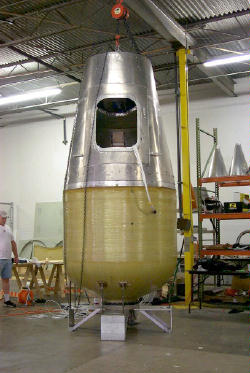We are developing the social individualist meta-context for the future. From the very serious to the extremely frivolous... lets see what is on the mind of the Samizdata people.
Samizdata, derived from Samizdat /n. - a system of clandestine publication of banned literature in the USSR [Russ.,= self-publishing house]
|
As is rather common in Belfast, it was cloudy earlier this evening. Even so, I laid the latest two issues of Sky and Telescope out on the bed, open to the sky map pages. I tried to interpolate where Mars would be tonight. The charts are basically for the East Coast USA, so they aren’t quite right for my considerably different longitude and latitude.
I needn’t have bothered.
Somewhat after midnight the clouds parted. I pulled on a jumper against the chill of the night. I went out into the too well lit parking lot hoping to navigate my way around the sky based on what ever made it through the glare. It’s not as bad as being in the city centre, but the sky glow here is still considerable.
I found Cygnus. Then I started looking for where I thought the plane of the ecliptic should be. Over in the general direction of the Belfast City Airport there appeared to be a plane in the pattern, and the brightness of its’ lights were an annoyance while looking for…. HOLY SHIT!!!
That was when I realized just how bright Mars is. I’ve seen oppositions before, but nothing remotely like this. The various astronomical news items have been just words. One suggested Mars might be bright enough to throw a dim shadow if you are in a sufficiently dark place. Another said Mars is nearer and brighter than it has been since Neanderthals were hunting Wooly Mammoths in Europe.
You really can’t miss it.
The September Astronomy issue reports what may be a cosmological bombshell. Time is continuous. It is not quantized. There is no such thing as an ‘instant’ of time, only a continuim. This makes the paper I discussed a few weeks ago look even more interesting than it did then.
The test is quite an elegant one. Light waves from a distant source exhibit fringes called an Airy disk. This is a set of rings around a central bright point with an appearance much like a Fresnel lens.
If we assume time is discrete, there are definable instants a quantum or Planck time interval apart. The speed of light in a vacuum becomes slightly fuzzy rather than exact. Photons that leave a source at the ‘same’ time would go out of phase by a small amount as they travel because some would travel slightly faster than others.
The theoretically proposed smallest time interval (the Planck time) is incredibly short. Phase slippage could not possibly be detected unless the light had travelled for an almost unimagineably long time: such as from a very distant galaxy. If time is quantized, the slippage in the phases should fuzz out the Airy disks of such distant objects.
Astronomers found sharp Airy disks. QED: time is not quantized. The work has already been replicated and seems fairly solid.
I await the theoretical fallout with great interest.
22 engineers and technicians died instantly in an explosion on the pad. This is the worst pad accident since the Nedelin disaster in Russia in 1960.
The X-Prize entry from Armadillo Aerospace is coming along nicely. They’ve carried out a helicopter drop test. They’ve acquired a Russian space suit – sans gloves so far – from eBay. They’ve got the landing legs sorted. Most importantly, they have finally sourced more high purity 50% Hydrogen Peroxide. They are still having difficulties convincing the manufacturer (FMC) to sell them the hi-test rocket fuel grade. Nonetheless, this lets them continue the engine test series so they can solve problems identified in an earlier firing.
Armadillo Aerospace was created by John Carmack, one of the founders of Id Software. If you want to support private enterprise in space, buy their games! Of course, since they are the creators of such titles as “Wolfenstein”, “Doom” and “Quake”, you probably have already done so.

X-Prize entry under construction
Photo: Courtesy Armadillo Aerospace
Many of you probably know Burt Rutan drop tested the second stage of his suborbital passenger spaceplane on August 7th. You might be interested in some of the details of this historic event. White Knight, the first stage, was piloted by Brian Binnie with Cory Bird as co-pilot. SpaceShipOne flew with Mike Melvill at the controls.
The flight report states:
The space ship was launched at 47,000 feet and 105 knots, 10 nm east of Mojave. Separation was clean and positive with no tendency to roll off or pitch bobble. An initial handling qualities evaluation was very positive, supported close correlation to the vehicle simulator and with that confidence, the first flight test cards were executed as planned. The flight provided handling quality and performance data over 60% of the expected subsonic flight envelope from stall to 150 knots. Trim sensitivity, stick forces, control harmony and L/D performance were all as expected. The on-board avionics and energy management cueing displays performed flawlessly, the gear extension rapid, and the vehicle made a smooth touchdown at 7:56 local on Runway 30 at Mojave. The entire flight, from launch to landing, was viewable from the ground and SpaceShipOne with its unique planform was intriguing to watch as it cut gracefully through the air and was put through its paces.
The test flight time was 1.1 hours for White Knight and 19 minutes for SpaceShipOne.
The biggest thing between them and a first suborbital private launch on the Wright Brothers First Flight Anniversary in December is a pile of US Government forms. These will hopefully be processed in time as the bureaucrats involved are, from what I have heard, doing their best within what the system allows.
The process was begun very late… I will not go into details as I believe Rand Simberg may have discussed this earlier in the summer.
The DOD announced a site for a new US missile defense system today: Adak Island.
This is exactly where I expected the first 21st century land-based ABM system would go. It is the most likely of two well placed islands in the Aleutians Chain extending south and west from Alaska. Adak Island is an old NSA Cold War listening post and has a military airfield.
It also just happens to sit almost exactly on the great circle route on which a North Korean based ICBM must travel to reach American soil. The DOD release doesn’t mention that little tidbit. You’ve heard it first on Samizdata.
While I’m on subjects Astronomical… don’t forget to keep an eye on Mars. On August 27/28 it will be at its’ closest approach to the Earth in recorded history. Calculations show humans have not had a Mars show this good in perhaps 50000 years. It is hard to be certain because chaos takes its’ toll when you run the solar system backwards that far.
This close approach is called an “Opposition”. It means the Earth and Mars are both in a line with the Sun and on the same side. It happens once every year when the Earth on its’ inner, faster track around the Sun catches up with the dawdling outer track Mars. The orbits of Mars and Earth are both slightly elliptical so the distance between the two varies with where the two bodies are on their elliptical paths. When Mars is at its’ closest to the Sun at the same time Earth is at its’ farthest, we have especially good views. The one coming up later this month is spectacular.
This does not mean you will see a Martian disk with your unaided eye. It does not even mean you will see views like a Hubble telescope from that cheap refractor you got for Christmas when you were aged twelve. However, if you have any amateur astronomer friends, they may be acting like giddy twelve year olds for the next two months. They will certainly be showing up at the office with bleary eyes and silly grins.
They will see detail they have never dreamed of seeing before. Of course there might be a global dust storm just after Opposition… in which case they will stare at the largest blurred reddish disk they’ve ever seen.
For the astronomically inclined there have been interesting goings on in the constellation of Scorpio these last three years. The star Delta Scorpii, a constant magnitude 2.3 for as long as anyone can remember, changed habits in July 2000. It has been a variable star ever since and not only that, seems to get a bit brighter on each cycle. It is now just a hair under becoming a first magnitude star. That means it is nearly bright enough to be seen in Manhattan and London.
As to exactly what is going on, no one seems quite sure, but it shows the sky is a changeable thing even on a human timescale.
Veteran space tourist Dennis Tito is ready to invest in a suborbital spaceship… but he is worried the FAA is going to regulate them like aeroplanes. He and others are worried this would kill the infant industry:
Jeff Greason, president of the Mojave, Calif.-based XCOR Aerospace, testified before the panel that holding suborbital vehicles like the one his company has in development to the same standards as airplanes would ensure that commercial space flight never gets off the ground.
In aviation, Greason said, the FAA’s focus is on keeping planes in the sky. When it comes to rocketry, the FAA assumes that the launch vehicle will fail and places most of the regulatory burden on ensuring that adequate measures have been taken to safeguarding people on the ground.
Greason called on lawmakers to help ensure that reusable launchers are treated as rockets, not as aircraft, as some in the FAA would prefer.
“If we insist on perfect safety at the beginning of the industry, we will get it, because no one will ever fly.” Greason said.
Perhaps one of our readers will drop in and expound on this at length. (wink, wink, nudge, nudge Jeff)
This link from Xcor points to the written testimony.
On July 21st, 1969 Neil Armstrong and Buzz Aldrin returned from the Moon after joining up with Michael Collins who had orbited overhead.
The last man set foot on the moon a few years later. All the hard work and miraculous efforts of thousands of dedicated scientists and engineers was thrown into the dustbin of history. World experts on esoteric science and engineering fields were fired and drove taxis to feed their families.
This is what happens when you place your faith in the State.

Photo D. Amon all rights reserved
Down load and play this song (vocals Julia Ecklar, words and music Bill Roper)
If you still don’t understand then you have no soul and I can’t help you.
When was the last time you heard anything about neutral particle beam technology? It seems like it almost vanished from the vocabulary after the 1980’s “Star Wars” program. From the information released by defense sources over the last few years one would conclude there isn’t much happening in that field. One might have concluded it was found to be a dead end.
But… why is everything to do with neutral particle beam technology included in the State Department’s ITAR Munitions List? In the most recent revision I’ve looked at (Sept 19, 2002) energy weapons technology has been promoted to an even higher profile. Neutral particle beams are included.
I wonder what’s going on out in the desert that I don’t know about?
I’ve been reading the discussion about Brian’s post on a possible USAF suborbital spaceplane project. It seems to me much of the discussion is overblown and ungrounded in reality. This is the expected next generation of military aircraft. An acquaintance of mine, Mitchell Burnside Clapp, championed a military space plane project named “Black Horse” a decade ago when he was a USAF officer. I have some of his papers on my islandone web site. Mitchell has been involved with commercial space ventures since he left the military.
This is not an ICBM or an ICBM derivative we are talking about. That is a non-starter for practical vehicles, whether for the warfighter or the commuter. It will be an aeroplane with a rocket engine. If it is a descendant of Mitchell’s design studies it will use in-flight refueling to top off the tanks. This reduces the weight of landing gear. They will only need to support a partially fueled craft. Once such a craft drops away from the tanker, it lights up and goes suborbital. It is not that much different operationally from the SR-71, it just goes a bit faster and higher.
Perhaps the USAF will buy from some of my other friends. There are some in the Mojave desert who would be more than happy to scale up to their suborbital design (XCOR). Brian has indicated this is a DARPA initiative, so contracts to companies like XCOR are a very real possibility. DARPA likes small groups with new ideas and has very little red tape or strings attached to their funding. I know. I’ve worked on DARPA projects myself.
This could be the real start of the commercial space launch industry. Greg Maryniak of the X-Prize organization has at various time spoken on this point. The early days of aviation were done privately and their products were then purchased by government. So airplanes are, in the minds of the person on the street, a commercial product. Rockets were built by and for government projects. Apollo made space travel a “government product” in the common mind. It was a false start and it has delayed space travel by decades. It sent us down a dead end road of manned artillery rockets and giant white winged elephants.
We are about to see a total conceptual change. People like those at X-Prize are changing the mind set. There are a dozen or more small companies building suborbital aerospace planes and ships. At least one (Rutan) will fly by the end of the year (target is mid-December on Wright Brothers first flight anniversary); several more will probably fly in the following 2 years. We are about to go back in time and start the space program over. This time we’ll do it the way the Wright Brothers, Glenn Curtiss and others did it. Privately but with the odd military or mail contract to keep body and soul together.
Suborbital aircraft are no revolution in aerial warfare. They bring no completely new capability to the USAF. It is advantageous to the aircrews. I am sure they will very much appreciate flight times of 1.5 hours instead of fourteen and up. As to those on the recieving end… I don’t much think they care what time the bomber took off and how long it flew before sending them off to Valhalla.
Where it may well be revolutionary is in US basing policy. It won’t change things over night. In a couple decades closure of US overseas air bases may be a viable policy option. That’s a salutory effect from where I sit.
We already are seeing the start of a retrenchment of US global forces. I suggested this outcome some months ago. We are moving large numbers of our forces out of Europe; we have moved out of Saudi Arabia; US troops are being pulled back from the truce line in North Korea. I can’t see us maintaining a high profile in Turkey any more. Even worse than being unreliable, they have had been working to assasinate leaders and destabilize the Kurdish areas of Iraq. Turkish black ops guys on such missions have been captured by US forces at least twice. We will be stuck in Afghanistan and Iraq for a long time, but it will not be comparable to the fifty year deployments in Germany and South Korea.
You may argue whether the US government intends this trajectory. Nonetheless, we are on it. The time will come when we can force a return to a “Fortress America” defense posture. There is no other possible path that will make it politically feasible for us to militarily disengage from the world. If we can defend ourselves against any attacker from anywhere on the globe and do so quickly from our own shores, we can satisfy worries of the most paranoid Hawk.
At the same time we will decrease our target profile amongst the nutcases of the world.
|
Who Are We? The Samizdata people are a bunch of sinister and heavily armed globalist illuminati who seek to infect the entire world with the values of personal liberty and several property. Amongst our many crimes is a sense of humour and the intermittent use of British spelling.
We are also a varied group made up of social individualists, classical liberals, whigs, libertarians, extropians, futurists, ‘Porcupines’, Karl Popper fetishists, recovering neo-conservatives, crazed Ayn Rand worshipers, over-caffeinated Virginia Postrel devotees, witty Frédéric Bastiat wannabes, cypherpunks, minarchists, kritarchists and wild-eyed anarcho-capitalists from Britain, North America, Australia and Europe.
|





